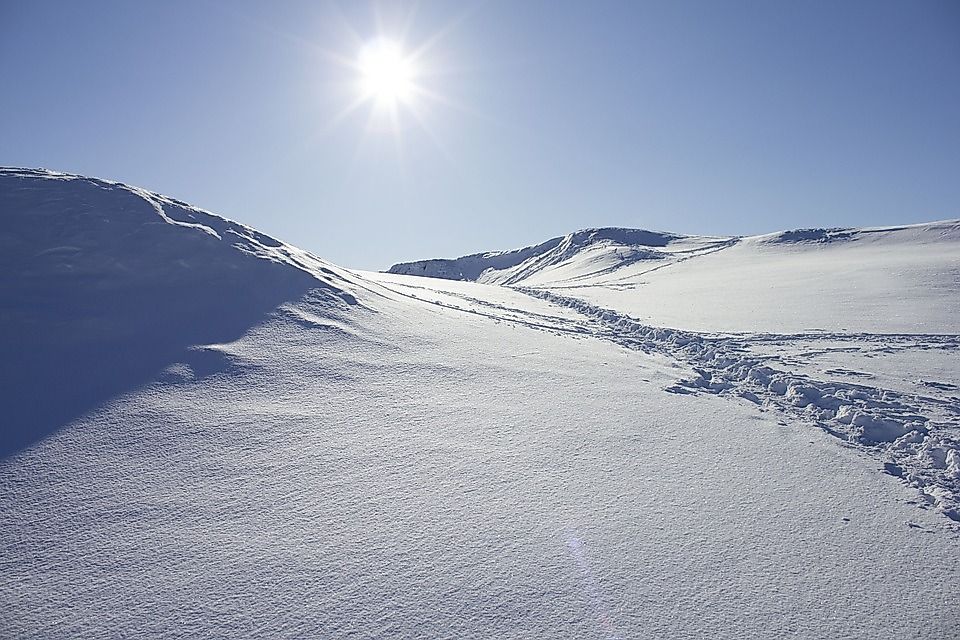The Glaciation Timeline

An ice age is a moment in time when global temperatures can reach drastically cold levels. The decreased temperatures prevent snow from melting which creates a layer of ice under all of the accumulating snow. This phenomenon causes the whole ice mass to move; in other words, a glacier is created. Glaciers carve out the surface of the Earth, leaving behind valleys and lakes. Once temperatures increase, glaciers melt and fill those valleys and lakes with water. It is believed that these eras are brought on by solar radiation and shifts in plate tectonics. A glaciation period is marked by glacial and interglacial periods. Glacial periods occur when temperatures are at their lowest and glaciers extend far from the poles. Interglacial periods happen when the temperatures are milder, and the edges of glaciers move closer to the poles.
Five Ice Ages
Huronian
Researchers have identified five separate ice ages. The oldest of these is the Huronian glaciation which occurred 2.4 to 2.1 billion years ago! During this time, the only living organisms on earth were unicellular. Temperatures were so low that the entire globe was covered in ice and snow. Theories suggest that this was caused by a 250 million year period of volcanic dormancy. This lack of volcanic activity reduced the levels of carbon dioxide gasses which meant the earth didn’t experience the greenhouse effect. No greenhouse effect means lowered temperatures.
Cryogenian
The next glaciation period the earth confronted was the Cryogenian period which lasted for 200 million years. This event occurred approximately 850 to 635 million years ago during the Neoproterozoic era. Earth now had more complex life forms like multicellular organisms. Theories about this period claim that the existence of these creatures caused the ice age. The idea is that when these organisms died, they fell to the bottom of the seafloor, taking away the carbon dioxide. Again, the lack of carbon dioxide reduced the greenhouse effect.
Andean-Saharan
After the Cryogenian period, earth experienced the Andean-Saharan glaciation. This happened about 450 to 420 million years ago and brought with it the first major extinction. Glaciers first formed in what is now Africa and eastern Brazil and slowly covered present-day South America. During this period, trilobites, brachiopods, and cephalopods made up animal life. They were all lost to this ice age.
Karoo
The 4th major glaciation to occur was the Karoo period. This event happened 360 to 260 million years ago and saw the next mass extinction of flora and fauna. The Karoo period was brought on by an extreme increase in plant life. The Earth was covered in plants that consumed all of the carbon-dioxide in the atmosphere and emitted high levels of oxygen. The oxygen was so high that the greenhouse effect did not happen, leading to yet another ice age.
Quarternary
Surprisingly, the earth is currently experiencing a glacial period. This one started about 2.58 million years ago and is still going on, this time with significantly milder temperatures. Antarctica first froze over about 14 million years ago due to the creation of the Himalayan mountains. The higher they grew, the more weathering they were exposed to which decreased carbon dioxide levels. This time, the glacial and interglacial periods were controlled by the orbiting of the earth and the levels of sun that reached the surface. The periods alternated every 41,000 years until 1 million years ago when the glacial periods changed to a cycle of 100,000 years. These cooled down temperatures possibly resulted in the evolution of homo-sapiens. Human brains became larger and when the ice caps moved closer to the poles, humans began to cultivate agriculture which led to today’s modern civilization.
What the Future Holds
Nobody has the exact idea of what the future holds for temperatures and glacial activity on Earth. Scientists agree that the Earth's temperature has certainly been getting warmer, with record-breaking warm annual temperatures. The melting of glaciers expands ocean water, which makes many areas of the world vulnerable to flooding. Among the effects of melting glaciers are shoreline erosion and salt water intrusion.
The Glaciation Timeline
| Rank | Ice Age Name | Period (in megannus) | Period and Era |
|---|---|---|---|
| 1 | Quaternary | 2.58 – present | Neogene, Cenozoic |
| 2 | Karoo | 360 – 260 | Carboniferous and Permian, Paleozoic |
| 3 | Andean-Saharan | 450 – 420 | Ordovician and Silurian, Paleozoic |
| 4 | Cryogenian (or Sturtian-Varangian) | 850 – 635 | Cryogenian, Neoproterozoic |
| 5 | Huronian | 2400 – 2100 | Siderian and Rhyacian, Paleoproterozoic |











